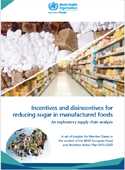Incentives and disincentives for reducing sugar in manufactured foods (2017)

Download
An exploratory supply chain analysis
The amount of free sugars consumed in Europe exceeds levels recommended by the World Health Organization (WHO). A significant proportion of free sugars in the diet comes from manufactured foods, such as baked goods, breakfast cereals and sugary drinks. Excess sugar intake increases the risk of weight gain and diet-related noncommunicable diseases (NCDs) and is one of the major challenges in Europe in relation to the promotion of healthy diets. Yet the high free sugars content of certain manufactured products and the significant variation in composition, within product categories and between countries, indicate that there is significant scope to reduce the amount of sugar added to manufactured foods.
Several countries have initiated national actions to reduce sugar intake, including reformulation, targeted taxation and interpretative front-of-pack labelling. These actions align with the policy tools recommended in the WHO European Food and Nutrition Action Plan 2015–2020 to create healthier food environments. Nevertheless, more fundamental action is needed.
The publication of the WHO guidelines on sugar intake in 2015 has led to increasing demand from countries for more specific guidance on policies to reduce sugar intake. One recommendation for more fundamental change made by the WHO Action Plan, which is also supported by an increasing number of international reports, is to align wider “food systems” goals with the goal of making healthy diets available, affordable and appealing.
In this context, this policy brief presents the results of a novel food supply chain analysis that identifies insights for governments to consider when designing sugar reduction strategies. It explores the incentives and disincentives to using sugar in manufactured foods throughout the “sugar supply chain” – the actors and activities that take sugar from farm to fork. It draws on the perspectives of entities working inside this sugar supply chain to explore the following key questions:
- What are the incentives and disincentives for industry to reduce the amount of sugar in manufactured food and drink products?
- At what point along the supply chain do these incentives and disincentives operate?
- Are there opportunities to effectively enhance the incentives and/or lessen the disincentives for reducing sugar?
The sugar supply chain consists of a series of stages: production (of sugar cane and sugar beet); trade (export and import of raw and refined sugar); processing (refining sugar cane and processing sugar beet); manufacture (adding sugar to foods and drinks); and retail (sale of manufactured sugary foods and drinks). This brief focuses on manufactured food and drink products from the perspective of industry actors in the supply chain, including producers, manufacturers and retailers.
The analysis reveals that, throughout the supply chain, there are currently more incentives than disincentives to use sugar in manufactured foods. Major incentives for manufacturers and retailers to use sugar in manufactured foods include the perception that sugar is the gold standard for sweetness, that sugar is needed to provide essential functional properties in manufactured foods, and that providing a range of products, including those high in sugar, is necessary to maintain “consumer choice” and competitiveness with other brands and retailers. The fact that sugar is a relatively cheap and abundant ingredient is not a direct incentive to use it, but means there is little incentive from the supply side not to use it.



